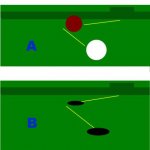It has been a while since aiming systems have been discussed, though some sparks have re-ignited over in the Backhand English thread. suprise, suprise 
Most now have recovered from their bruises from previous discussions...even DM's knuckles have mostly healed up Though the palm of his hand is still a bit blistered
Though the palm of his hand is still a bit blistered  *couldn't resist*
*couldn't resist*
Anyway, I've learned a few things in previous discussions and put my foot in my mouth a few times too. I'll likely do it again, but going out on a limb with a viewpoint is sometimes the best way to expose our weaknesses and to learn.
So, I want to revieve an aiming discussion. Newbies might benefit from reading some of the previous aiming threads.
The reason is, I am re-assessing my take on aiming systems. That doesn't mean I don't think 'feel'...let's call it intuitive judgement "IJ" isn't important. I think it will always play a large role in billiard skill. Speed for one thing.
So, what system to use? I like aspects of the 'Aim and Pivot' method proposed by Fred. I have argued that the system is not universal, that is, it cannot account for all distances, all angles, all bridge lengths and all speeds. However it may be a useful approximation through a relatively wide range of shots (say 70-80% of english shots played in matches).
That's enough to kick the thread off. Hopefully it can lead to a better understanding of aiming systems, how many we need, which are the easiest and when to just wing shots and learn them through repetition.
Also, lets not just discuss aiming systems for using English, how about some systems for standard potting of straight and angled shots.
Most now have recovered from their bruises from previous discussions...even DM's knuckles have mostly healed up
Anyway, I've learned a few things in previous discussions and put my foot in my mouth a few times too. I'll likely do it again, but going out on a limb with a viewpoint is sometimes the best way to expose our weaknesses and to learn.
So, I want to revieve an aiming discussion. Newbies might benefit from reading some of the previous aiming threads.
The reason is, I am re-assessing my take on aiming systems. That doesn't mean I don't think 'feel'...let's call it intuitive judgement "IJ" isn't important. I think it will always play a large role in billiard skill. Speed for one thing.
So, what system to use? I like aspects of the 'Aim and Pivot' method proposed by Fred. I have argued that the system is not universal, that is, it cannot account for all distances, all angles, all bridge lengths and all speeds. However it may be a useful approximation through a relatively wide range of shots (say 70-80% of english shots played in matches).
That's enough to kick the thread off. Hopefully it can lead to a better understanding of aiming systems, how many we need, which are the easiest and when to just wing shots and learn them through repetition.
Also, lets not just discuss aiming systems for using English, how about some systems for standard potting of straight and angled shots.
Last edited:
